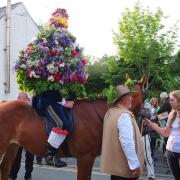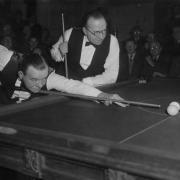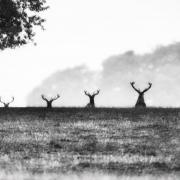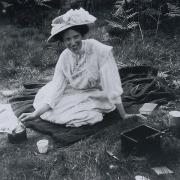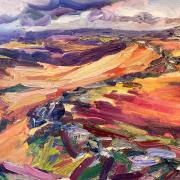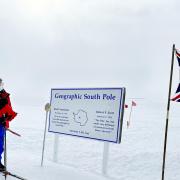Celebrated artist Rob Rowland is something of a master when it comes to capturing the past through evocative art – not least through quirky pub signage which seems to be gradually disappearing. Not if he can help it, though
Once upon a time you would see them everywhere in the countryside.
Hand-painted signs that were merrily painted, often comical and always welcoming - highlighting some feature or other of rural life, hanging above the entrance of virtually every village pub.
Today, pub sign painters can still be found, but new thinking about how to attract customers – especially among pub chains and brewery pubs, so-called ‘pub companies’ currently owning about half of Britain’s stock of free houses – has caused a proliferation of less exciting, some would say ‘trendier’ designs, which often look more like business logos.
Simply put, these modern incarnations tend to lack the exuberantly vivid charm that we used to associate with inn signs.

Because of this, many now, unfortunately, see this traditional painting style as unfashionable.
The eminent artist Rob Rowland doesn’t paint pub signs any more but he has certainly done his fair share of pub signs over the years.
‘I must have completed around 1,500 double-sided pictorial signs since 1983 when I first started,’ says Rob, a distinguished member of the Guild of Railway Artists. ‘Not forgetting that the picture has to be painted twice, once for each side of the sign.’
And masterpieces his designs certainly are. In Rob’s opinion, a good inn sign artist is predominantly an illustrator.
However, because the illustration or pictorial content is painted onto a signboard instead of being used in a book or magazine, for example, people often incorrectly refer to a pub sign artist as a signwriter.
A number of eminent and artists in the past, including John Constable, Sir John Millais, Walter Crane, C.R. Leslie and William Hogarth, have painted pub signs during their illustrious careers.

Originally, many pub owners would approach Rob for pub signs because they were wanting the vividness and charm that his own personality brings to the design.
Yet in these modern times, for some new pub owners it is precisely the look of such traditional-looking pub signs that they are anxious to drop in their bid to transform their pubs into gourmet haunts where customers who will spend more.
It means these once familiar and much-loved signs welcoming customers to our pubs both here in Derbyshire and across the country are in danger of becoming fondly remembered relics of a bygone age.
That’s not to say such signs aren’t designed to last.

‘On average they’ll last for seven or eight years but it would really depend on where the sign was situated,’ Rob tells Derbyshire Life.
‘It would last longer in a more sheltered environment, for example, as opposed to somewhere more exposed to the elements.’
One organisation that sets out to stem the gradual disappearance of traditional pub signs is The Inn Sign Society, which in 2012 made Rob the winner of their Sign of the Year competition.
The Society has a simple plan and aim: to collect as many photographs of Britain’s existing hand-painted pub signs as they can from anyone happy to send them in, especially those that are in danger of disappearing.
Thus, the design can remain safe in their repository of pictures which they keep for posterity, so that later they can even, hopefully, appear once more.
With this in mind, if any readers spot traditional pub signs they like the look when enjoying a drink or bite to eat in some of our county’s fabulous traditional pubs, send your pictures to innsignsociety.com.

But what it is it that makes a good sign?
‘A good pub sign has to be tailor-made, not just as a painting but as an advertisement, with a striking image to draw the public in,’ Rob argues.
‘The age-old traditional method of producing a pub sign by painting directly onto a sign, using a brush, has now virtually been completely superseded by using digital technology.
‘I suspect many images have simply been scanned directly from printed sources which may have been suitable for their original purpose but not for a pictorial sign.’
Nevertheless, Rob can see the wheat from the chaff.
‘There are still some very good ones,’ observes Rob, ‘and as a sign is hung for all to see it is important to be careful with visual information as there will always be someone who will notice if a mistake has been made!’
Times change and it appears the heyday of traditional pub signage is behind us. Nevertheless, Rob has heard of one or two well-known breweries which have been talking about bringing traditional inn signs back.
Could we be set for an unlikely resurgence? Time will tell.
While Rob would naturally welcome the return of such days, his talents are by no means dependent on them returning.
His passion nowadays, and has been for many years, is painting scenes of Britain’s industrial heritage, with Derbyshire and its surrounding areas having joined the growing list of his subjects. And what a canvas the county offers him. Railways, canals, rivers, farm machinery - he has done the lot.

This work includes countryside themes which mean a lot to Rob. Born and raised in the Midlands in the 1950s and 60s world of cobbled streets, gas lamps, back yards, canals and railway viaducts, he sees representing aspects of our past as a good way to help protect that heritage - particularly if it’s something unique, such as an accurate depiction of a particular vehicle that has never before been recorded.
‘I love the idea of recreating a scene from the past where there may be no actual visual record of it at all,’ he says.
‘A lot of research is necessary to get details correct because you are laying down historical facts. Sometimes railway and other preservation societies are a great help in this. I especially love the Victorian era. It saw the pinnacle of craftsmanship.’
Every painting he completes is another piece placed in history’s jigsaw and the awe-inspiring effect his paintings have on anyone looking at them is testimony itself.
There is an obvious affection for his subjects, whether it is steam trains or traction engines. It comes from things he remembers from his midlands-based childhood.
His remarkable pub sign paintings used to fill this bill too, with this modest painter always seeking to produce ‘truly stunning images describing a past era and evoking particular memories for many.’
Rob Rowland is nothing less than a modern-day Constable himself.
Even if uncertainty about art as a way of life remains unchanged after two centuries – Lancashire artist Joseph Farington’s diary recording of June 29 1801 states: ‘Constable called. His father has consented to his practising in order to profess painting, but he thinks he is pursuing a shadow. Wishes to see him employed.’ – I suspect few would wish Rowland to ever stop either.
robrowland.co.uk














